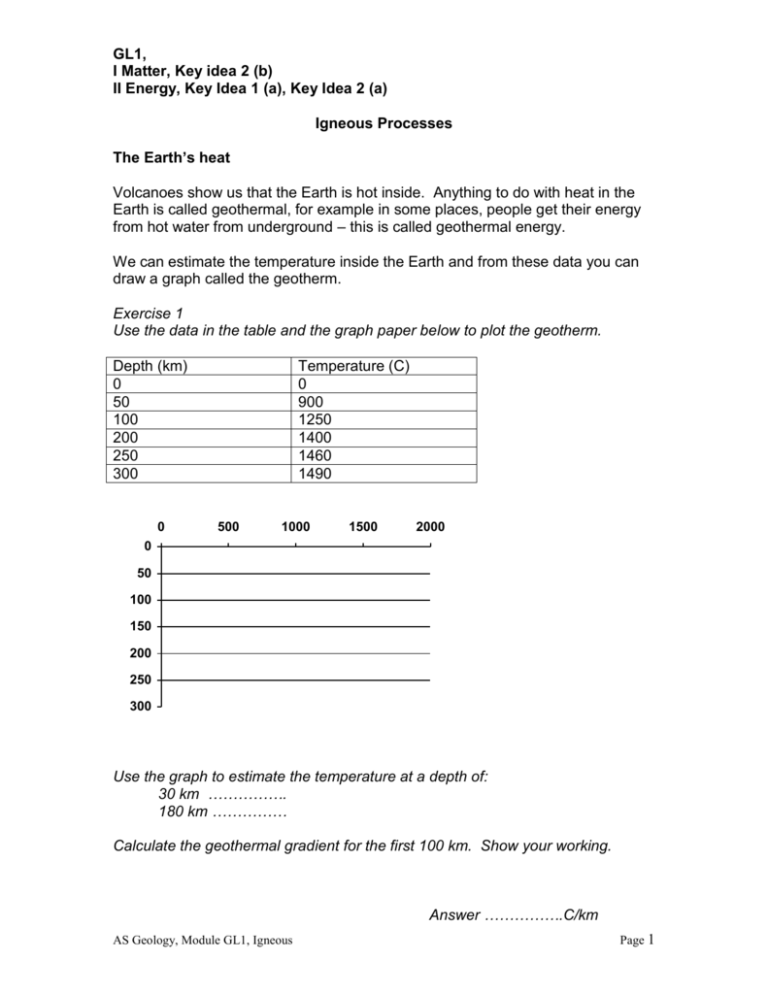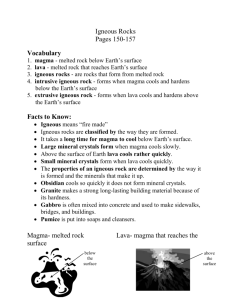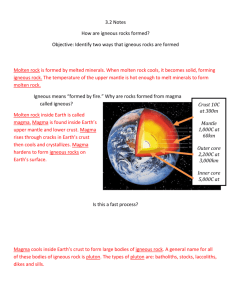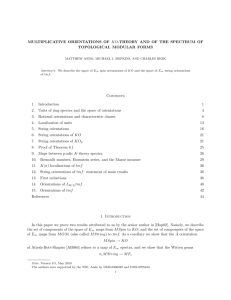Introducing Igneous Rocks
advertisement

GL1, I Matter, Key idea 2 (b) II Energy, Key Idea 1 (a), Key Idea 2 (a) Igneous Processes The Earth’s heat Volcanoes show us that the Earth is hot inside. Anything to do with heat in the Earth is called geothermal, for example in some places, people get their energy from hot water from underground – this is called geothermal energy. We can estimate the temperature inside the Earth and from these data you can draw a graph called the geotherm. Exercise 1 Use the data in the table and the graph paper below to plot the geotherm. Depth (km) 0 50 100 200 250 300 0 Temperature (C) 0 900 1250 1400 1460 1490 500 1000 1500 2000 0 50 100 150 200 250 300 Use the graph to estimate the temperature at a depth of: 30 km ……………. 180 km …………… Calculate the geothermal gradient for the first 100 km. Show your working. Answer …………….C/km AS Geology, Module GL1, Igneous Page 1 The centre of the Earth is very hot indeed. The main source of the Earth’s heat is radioactive decay. Some elements have unstable atoms, when they break down (decay) they change into different atoms and give out energy. Like any hot object, the Earth loses its heat and slowly cools down. The outer part of the Earth is rigid (it doesn’t flow) so it cools by conduction. Deeper layers are ductile (they can flow) so they lose heat by convection. As you go down into the Earth, the temperature that rocks melt changes. We can show this on the geotherm graph using a melting line. If the geotherm crosses the melting line, then the rocks melt at that depth and form magma (liquid rock) 0 500 1000 1500 2000 0 50 100 150 200 250 300 350 400 Exercise 2 Sketch the melting line on the graph above (see page 34 Geoscience). Estimate the depth at which magma is formed. Magma Magma is the name given to liquid rock under the surface. In reality it is a complex mixture of substances, mostly silicate minerals plus water and gases. The amount of silica is a very important factor in controlling the behaviour of the magma. Magma rich in silica (>66%) is called acidic, medium amounts of silica (54 – 66%) is intermediate, low proportion of silica (<54%) is called basic. The amount of silica controls the viscosity of the magma or lava. The higher the proportion of silica, the more viscous (sticky) the magma is. The magma will tend to rise through the crust towards the surface. If it breaks out onto the surface, the gases are lost into the atmosphere and the liquid rocks is now called lava. AS Geology, Module GL1, Igneous Page 2 Volcanism Lava can erupt at the surface through cracks called fissures or from a single hole called a vent. In the case of a central vent, the lava will build up a cone shaped mountain as it cools – this is a volcano. The size and shape of the volcano is controlled by the type of eruptions and the products of the eruption. Some volcanoes erupt basic lava which has lower viscosity, the gases are able to escape easily and the eruptions tend to be gentle (effusive). The volcano produced in this way is broad and flat, this is called a shield volcano. Exercise 3 Sketch a typical shield volcano and give an example. Volcanoes formed from more viscous (usually intermediate) lava tend to be taller and steeper. These are called composite cone volcanoes (stratovolcanoes). The eruptions are much more violent. Exercise 4 Sketch a composite cone volcano and give an example. (e.g. page 65 in Geoscience) . The lava cooling from a volcano, loses its heat very quickly. The result is a solid rock made of randomly arranged, small, interlocking crystals. This is a description of the texture of the rock. In geology we use the word “fine” for small crystals, these are crystals less than 1 mm across. The main fine grained rocks are: AS Geology, Module GL1, Igneous Page 3 Acidic Intermediate Basic Rhyolite Andesite Basalt If lava cools very quickly there is not enough time for the crystals to form. Instead volcanic glass is created, this is called obsidian. Lava can be erupted under water – there are many volcanoes at the bottom of the ocean, following the ocean ridges. When the lava comes into contact with the water it cools almost instantly – there is no time for crystals to form, the rock is glassy. The shape of this lava is a “blob” called a pillow. The pressure of the lava inside causes the pillow to break and another pillow forms. Exercise 5 Sketch the formation of pillow lava.(e.g. McLeish) Intrusions Sometimes magma never reaches the surface, so a volcano does not form. Instead, the magma cools within the crust to form an igneous intrusion. Small scale intrusions quite near to the surface are called hypabyssal. There are two main types. A sill is a tabular (like a table top – flat sides) intrusion which follows the beds of rock around it (we say it is concordant with bedding). A dyke is a tabular igneous intrusion which cuts across the beds (we say it is discordant with bedding). Exercise 5 Use Geoscience page 66 to sketch a sill and a dyke. AS Geology, Module GL1, Igneous Page 4 The rocks in a sill or dyke have medium sized crystals because the magma cools more slowly than lava at the surface. Medium grained rocks: Acidic Intermediate Basic (Don’t need to know) (Don’t need to know) Dolerite Sills and lava flows may both have columnar jointing. This is a type of structure caused by tension in the crystallising magma. The columns are perpendicular to the base and have a polygonal shape. Exercise 6 Sketch the appearance of columnar jointing. Deep, large scale intrusions are called plutonic intrusions. The main example is a batholith. Batholiths are made of coarse grained rocks, formed by the slow cooling and crystallisation of the magma. Coarse grained rocks: Acidic Intermediate Basic Granite (Don’t need to know) Gabbro AS Geology, Module GL1, Igneous Page 5 Exercise 7 Using a textbook, complete the table below to describe the appearance of the rocks you need to know. Try to say the main minerals present in each. Coarse Size = Acidic Granite Medium Size = X Fine Size = Rhyolite Glassy No crystals Intermediate X X Dolerite Andesite O B S I Basic Gabbro D Basalt I A N Describing igneous rock textures When you describe the texture of an igneous rock, you need to describe the following features: Grain size - Coarse Medium Fine Glassy Grain shape - Euhedral = well formed crystals Subhedral = moderately well formed crystals Anhedral = poorly formed crystals If the rock has two distinct grain sizes, it is described as porphyritic. Large, well formed crystals are called phenocrysts. Smaller crystals surrounding the phenocrysts are called the groundmass. Porphyritic texture is evidence for two stages of cooling. AS Geology, Module GL1, Igneous Page 6 Exercise 8 Using diagrams, explain how two stages of cooling can be used to explain the formation of porphyritic texture. Gas escaping from lava may leave bubbles in the solidifying lava – these are called vesicles. A rock with vesicles is called vesicular. ESTA GEOTREX The Geology Teachers Resource Exchange Contributor: Owain Thomas Establishment: Amman Valley School Date: 22:04:05 AS Geology, Module GL1, Igneous Page 7








